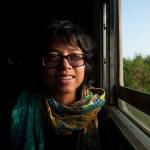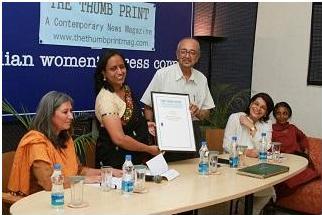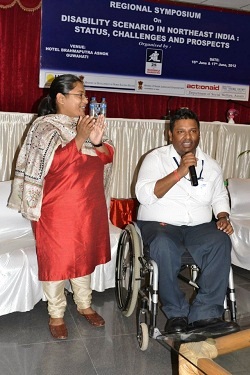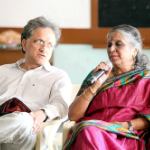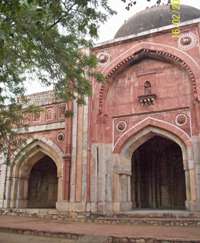Going to Mae Sot was a tad awkward. We were in a group visiting the place for 'educational' purpose. We would visit a number of organizations and go to the camps. An atmosphere of adventure and danger was created beforehand by the organizers. The camps have high security and people are not allowed to get in without permission. We will not be allowed to take photos. We must be very careful not to talk to anyone in the camps. We must be careful about the questions we ask...
As we reached town and went to the friendship bridge across the border, I felt like a development tourist. People who go to see other unfortunate people supposedly to understand their condition and ambitiously to offer solutions. The friendship bridge as I had mentioned earlier is across the river Moei. Like in many other parts of the world, the river is the border. And like Pitch Pongsawat - assistant professor of Political Science at Chulalonkorn University had warned us earlier in Bangkok - 'the border is not a white line drawn between two countries.'
Pitch Pongsawat had also said, 'to understand borders - border politics, border economics and border people - one must first understand that for people who live on the border, the border is their centre. Therefore we must first move the centre and establish the centre at the border if we want to understand borders.' It reminded me of home again. For the North-East is nothing but a border land, its people the border people. The borders play a central role in the lives of people of various North-Eastern states in various ways. And I thought the reason for its unrest is also that somewhere during the course of history our people lost their centre and became border people for themselves too.
At one end of the friendship bridge at Mae Sot is Thailand, the other end is Burma. The bridge itself is a no man's land. So is the river below. The Burmese people, who are not allowed to enter Thailand through the border post without papers however, can cross the bridge or the river by boat in rainy season and on foot when it is dry till to the Thailand side. All they long you see people carrying loads on their head, on wheel burrows across the bridge, never crossing it but ferrying in between the two ends. From Thailand they will carry packet food, clothes and stationeries. From Burma they bring gems, forest products, sandal wood and such. As soon as the border posts open in the morning on both sides, you will see hoards of people going up and down the bridge ferrying the goodies legal and illegal. You will see them carrying crates of coca cola bottles which are illegal but are allowed in for personal consumption. A person carrying 10 crates of coca cola bottle will tell the border guy it is for their personal consumption. A small bribe along with the innocence helps in the convincing. The bottles end up in shops across the border.
On the bank of the Moi river on Thailand side, there are small shops that are built on stilts on the river. So technically these stalls are not in Thailand. But their fronts are at level with the river bank, which is Thailand. There is a few inches gap in between the stalls front and the bank. But you can easily stand on Thai land and buy porn dvds, Viagra tablets, cheap alcohol, medicine and Chinese nick-naks from the shops. Such wonderful arrangements! Makes you think about the purpose of the legal and the purposefulness of the determined. It reminded me of the borders we share with our neighbours.
In Moreh, I was told by a local politician-businessman that, the legal business amounts to hundreds of crores of rupees in a day. The illegal amounts to double that money. The borders posts with Bangladesh see the same. Legally India sends Bangladesh medicine, clothes, durables and food. Illegally they send cows! My point is, across all borders, if animals and goods can cross over so freely can human beings be stopped?
So at Mae Sot, hundreds of thousands of displaced people from Burma have poured in. As Pitch Pongsawat pointed out again, the development of Mae Sot as the biggest border trade and industrial hub of Thailand has not happened by accident. The govt. of Thailand has banked on the fact that like it or not Burmese people are coming into Thailand looking for security and livelihood. Cashing in the vulnerability and need of the people the Thai government has developed what Pitch calls a regime of 'partial citizenship' and economic policies that allow Thai business to profit extensively from the cheap labour available in Mae Sot - a labour force without rights.
Not having legal rights, however, have not stopped the Burmese population from doing things for themselves. Over the years, a larger number of organizations have come up to organize the people for education, health, for labour rights, for justice - for a more humane life. Along with trying to improve their daily living condition without any support from the state, they have been keeping the hope of a revolution alive. They hope that one day change will come to Burma. One day the Junta will see the people. One day they will be able to go back home.
During our visit we met with a number of organisatiosn working with Burmese immigrants. Karen Women's Organisation is one that has been working with the women in the camps for more than 25 years. The organization was formed in 1949 in Karen State, Burma, as part of the Karen resistance movement. The resistance movement wanted autonomy and political recognition of the Karen people in the newly formed Burma with Burman people in centralized authority. (Doesn't that sound familiar too?) Burma had attained freedom from the British rule a year earlier in 1948. The military government in Burma came into power in 1962. Ever since, Karen people have been facing inhuman atrocities, forced labour, conscription of child labour, rape and sexual abuse in the hands of the Burmese Army. As a result for 35 years they have been flying to the 'safety' of Thailand.
In the refugee camps KWO started organizing the women - to provide economic opportunities, to address the questions of gender inequalities within the community and to provide justice to women when there are cases of abuse, violence, deception etc. Their income generation activities are designed in a way that would stop the women from becoming cheap exploited labour in the factories. They also play an important role in the movement for democracy that brews with muted hope within the displaced people in Mae Sot.
The Mae Tao Clinic started by Dr. Cynthia Maung is another place we visited where the human spirit has sprouted through extreme adverse conditions. In 1988, Cynthia, a newly graduated medical practitioner, ran away to Thailand along with many of her colleagues, escaping the heavy crackdown of the military forces on the protesters in the student uprising for democracy. They reached Thailand and saw hundreds of people suffering in the newly set up refugee camps at Mae La near Mae Sot. There were hundreds who had been injured during their flight through the deep jungles of Myanmar. Many had been wounded in army attacks, still many especially children were falling ill due to the living conditions in the camps. Cynthia started providing health care to the people in the camps but soon realised there needs to be more organized health care set ups with provisions for medicine and facilities for surgery.
Thai government allowed Dr. Cynthia and her team to set up a clinic in Mae Sot in a dilapidated building. Equipment and medicines were still hard to come by. The team was innovative and used whatever was available to provide the best treatment they could manage. They used rice cookers to setrilise instruments and operated in the one room setup. On the day we visited the clinic in March 2012, the clinic was providing treatment to 500 people daily on an average. Along with the displaced people who live in Mae Sot, many who are still living across the border in Burma also come to the clinic seeking treatment. For in the bordering states of Burma, there are no hospitals and most people live in camps after running away from the villages. There is a display that shows the number of landmine injury cases that have been treated at the clinic since 1988. They list had run out of one board into another. The number increases each year.
At the clinic the atmosphere was genial. Everyone works quietly with smiling faces. The patients wait patiently and there is no commotion, no dirt, no long que anywhere. At the maternity section, the ward has been decorated with colourful papers. The women help each other comb and tie their hair, put on their tanakha. The babies are looked after by all the mothers. The accompanying children are looked after by the fathers in groups. The attendants of the patients help the workers distribute food and clean the place.
The Backpackers Health Workers Team is another group that we visited in Mae Sot. Once again a group of students who ran away after the 1988 student uprising, realised there were still many left inside Burma without any health care support. They started smuggling in medicine on their backs walking through the jungles to find the people who have fled their villages and are living in the jungles of Burma. In 1998 the group registered formally and has been receiving support from donor agencies. They have trained local people in the IDP camps as health workers for the community. A team of backpackers carry medicines every six months to replenish the stock that they distribute in the camps. The jungles are treacherous, filled with landmines laid by the Burmese army. There is also possibility of an ambush any minute. The backpackers however have not skipped a single time since they started their work. They have lost a few colleagues over the years. But they march on.
Like these organizations, there are many more Burmese people's organizations in Mae Sot working towards attaining a better life, a more promising future for their children. The language barrier and the education policy of the Thai government for example are not supportive towards providing higher education for the Burmese children in the camps. The people have set up their own schools and are running many skill building trainings for the children.
The workers who have no rights have organized themselves to form unions to negotiate their dues. Some of these attempts are not taken well by the Thai government. The challenges they face are large, legal and daily. They still continue. Many international organizations and workers have helped the Burmese people in these endeavors. The Thai government, although not taking any initiative to help the people on its own, has allowed others do help the migrants in their country.
Given the number of displaced people in camps in North-East at the moment, one needs to think what could be an attempt at addressing their human developmental needs. In Tripura, the Bru people who were thrown out of their homes in Mizoram are living in camps since 1997. In Kokrajhar affected people from the Bodo-Adivasi conflict are still in camps since 1998. From the latest violence in Kokrajhar hundreds of thousands have again found themselves in camps. Their situations are similar to that of Mae Sot in the beginning - no health care, no education, no food, no livelihood, no recognition, no rights. Will we be able to come up with plans that will allow the children to develop completely and to have a fearless future? Will we be able to keep alight the human spirit? We need to keep these questions and the experiences of people from all over the world if we actually want to see an end to the violence.
Find us on facebook: facebook.com/TheThumbPrintMag

